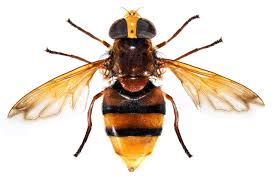Hoverflies : New Species

Three Kashmiri scientists recently discovered a new species of hoverfly that mimics the wasp in the high-altitude alpine forests.
- Hoverflies sometimes called ‘flower flies’ or ‘syrphid flies’, are any member of a family that contains about 6,000 species of insects in the fly order, Diptera.
- Their various common names refer to the behaviour of hovering around flowers.
- They are found worldwide, from temperate regions to tropical environments.
- Hoverflies, with their yellow markings, resemble wasps or bees but do not bite or sting.
- They can be readily distinguished from wasps and bees by their single pair of wings.
- They are distinguished from other flies by a false (spurious) vein that closely parallels the fourth longitudinal wing vein.
- The species vary from small, elongated, and slender to large, hairy and yellow and black.
- They also have a typical fly head with short antennae and bulbous eyes.
- Beneficial Insect : Adults feed on nectar and pollen, making them important pollinators in a variety of habitats.
- The larvae of many species feed on aphids (soft-bodied insects that use their piercing-sucking mouthparts to feed on plant sap), mites and small insects helping to control populations of these pests.




